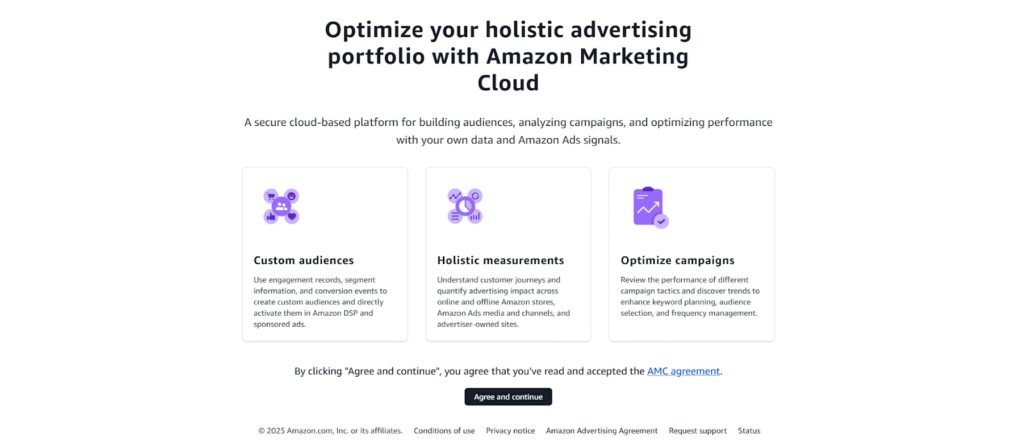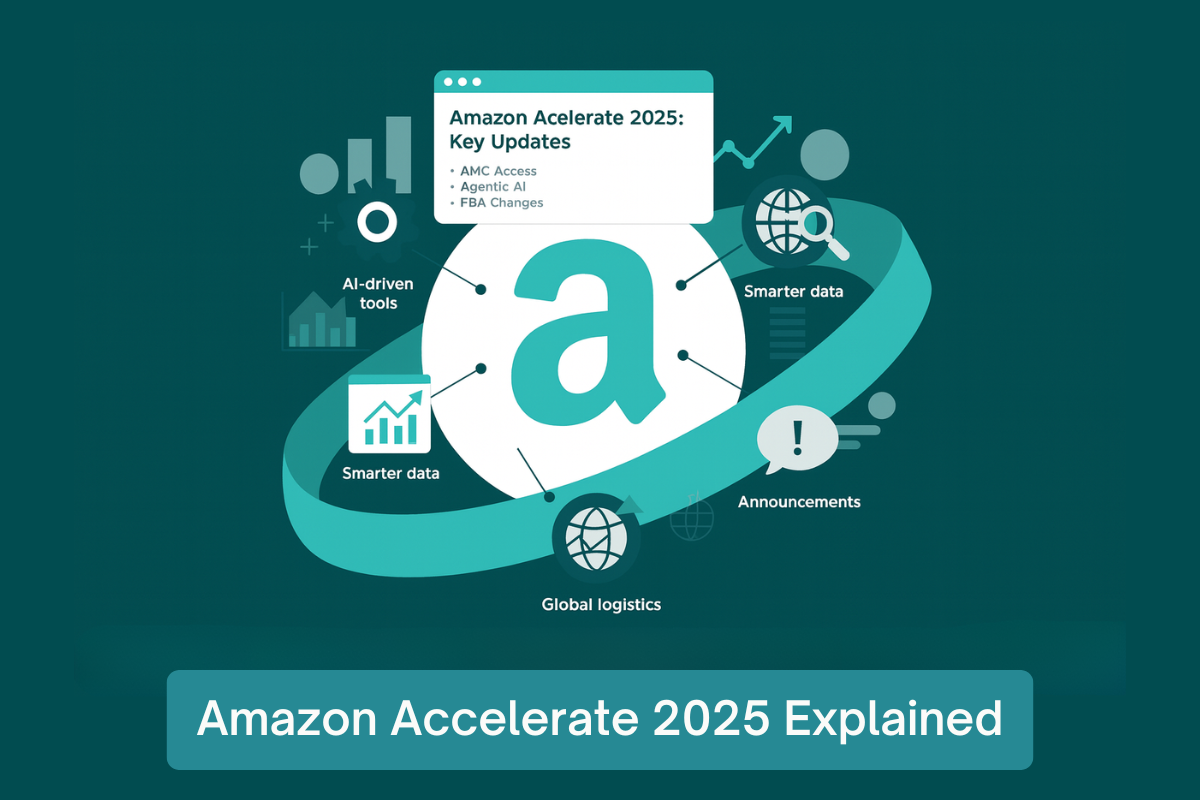Introduction: The New Amazon Era
Amazon sellers today face a crowded marketplace, rising ad costs, and constant operational challenges. Add in fast-moving platform updates, and it’s easy to feel like you’re always catching up.
That’s why Amazon Accelerate 2025 matters. Every year, Amazon uses this event to unveil its biggest updates for sellers, and this year was different. From AI-driven tools to sweeping policy changes, the announcements point to a future where automation, smarter data, and global logistics reshape how brands succeed on Amazon.
In this guide, we’ll break down the most important updates, explain what they mean for you as a seller, and give you practical strategies to take advantage of them. Whether you’re a new brand figuring out your first product launch or an experienced seller ready to scale globally, the insights from Accelerate 2025 can help you compete more effectively.
Amazon Marketing Cloud Access: How to Enable AMC Without DSP
Until now, Amazon Marketing Cloud (AMC) was locked behind DSP access. That meant smaller sellers had to rely on surface-level metrics like ACoS and last-click attribution. Accelerate 2025 changed the game: AMC is now accessible directly in the Advertising Console.

This means:
- You no longer need a DSP seat or developer support.
- Every advertiser, big or small, can see cross-campaign performance.
- Multi-touch attribution and conversion paths are visible, not just the last click.
What sellers can expect when enabling AMC in the console:
- A new AMC tab appearing in the Advertising Console.
- Ready-to-use dashboard templates that simplify audience analysis and funnel reporting.
- The option to dive deeper with custom queries once you’re familiar with the basics.
- Insights that go beyond last-click attribution, like branded vs. non-branded conversions or multi-ASIN purchase paths.
At Bits & Atoms, we’ve been working with AMC and DSP for some time now. What excites us about this update is that the advanced data once reserved for enterprise-level advertisers is now accessible to everyone. The challenge for most sellers won’t be access, but knowing how to interpret AMC insights and apply them to their campaigns.
Strategic takeaway: AMC lets you spot hidden opportunities, like keywords with high purchase share but low impressions. Sellers who learn how to ask the right questions, and connect insights to action, will pull ahead.
Tip: If you don’t have in-house expertise, this is an area where partnering with an Amazon PPC agency can accelerate your learning curve. See our Amazon Advertising Service for support.
Amazon Agentic AI Seller Assistant: Setup and Best Practices
The new Agentic AI Seller Assistant isn’t just a chatbot. It’s a proactive partner designed to monitor account health, inventory, compliance, and even take action with your approval.
What sellers can expect:
- An integrated tool inside Seller Central that helps you manage daily operations.
- AI that proactively flags issues, from compliance risks to stranded inventory.
- The ability to approve or decline automated fixes, keeping you in control.
- Logs and reporting that explain what actions the AI recommends or has taken.
Best practices:
- Start small. Let the assistant monitor account health before granting it full action rights.
- Review weekly logs to understand its decision-making.
- Use it as an early-warning system for compliance and inventory issues, freeing you to focus on growth.
Why it matters: Instead of firefighting problems after they happen, you can now run your Amazon account proactively.
End of FBA Commingling 2025: What It Means for Brands
For years, inventory commingling meant Amazon pooled identical products from different sellers. While this sped up shipping, it also led to counterfeit risks and quality issues.
By the end of 2025, commingling is officially ending. Amazon will shift to stickerless, brand-controlled inventory.
Implications for brands:
- Greater protection from counterfeit and gray-market sellers.
- Assurance that customers receive your inventory, not someone else’s.
- Lower costs: Amazon estimates brands save ~$600M annually by not relabeling inventory to avoid commingling.
Action steps:
- Ensure your products are enrolled in Brand Registry.
- Use GS1-certified barcodes for proper traceability.
- Update SOPs for inventory tracking, you’ll be fully accountable for product quality.
This policy shift restores buyer confidence and rewards sellers who invest in authenticity.
Amazon Creative Studio AI: Video Generator Tutorial
Creating ads used to mean expensive shoots and long production cycles. With the new Amazon Creative Studio AI, you can generate complete ad assets: images, videos, and copy inside the console, much faster than before.
What’s new with Creative Studio AI:
- AI-driven video generation that produces short promotional clips in minutes.
- The ability to generate lifestyle imagery and ad copy variations from your product details.
- Built-in integration with Adobe Express for refining and customizing assets.
- Creative outputs tailored for different funnel stages (awareness, consideration, conversion).
Why this matters: Advertisers already using Amazon’s video tools have seen sales lifts of over 10%. For smaller brands, this means pro-grade creative is no longer limited to big budgets.
Pro tip: The real advantage isn’t just faster content, it’s the ability to test and iterate multiple variations quickly, and then use AMC insights to see which creative resonates with your audience.
FBA Regional Launch: A Lower-Risk Way to Test Products
Amazon is introducing a Regional Launch option for FBA, giving sellers more flexibility when bringing new products to market.
Instead of committing large amounts of stock nationwide, sellers will be able to start smaller, focusing inventory in select regions while still offering Prime delivery speeds to those customers. This approach helps test demand, gather early sales data, and avoid the risks of overstocking or understocking at launch.
Why this matters for sellers:
- Lower upfront costs for new product launches.
- Faster feedback on how a product performs in real-world conditions.
- The ability to scale gradually with data-backed confidence.
Global Warehousing and Distribution (GWD) for Amazon Sellers: A Guide
Amazon announced Global Warehousing and Distribution (GWD) as a way for sellers to position inventory closer to their manufacturing hubs, particularly in Asia. The goal is to reduce costs and speed up replenishment into FBA centers worldwide.
The program is expected to:
- Offer more affordable storage options compared to US or EU warehouses.
- Shorten lead times by keeping bulk inventory staged near factories.
- Provide flexibility for sellers scaling into multiple markets.
For brands manufacturing overseas, GWD could mean more control over inventory flow and less reliance on costly international shipments. As Amazon shares more details, sellers should evaluate whether staging stock abroad fits their supply chain strategy.
Profit Analytics: Smarter Scenario Planning
Profitability has often been a blind spot for sellers. Amazon’s new Profit Analytics tool brings all costs (FBA fees, storage, returns, ad spend) into one dashboard.
A new scenario planning feature is being introduced, allowing sellers to model the impact of different strategies before making changes. For example, you could explore how a pricing adjustment or advertising shift might affect your margins, all within the dashboard.
Why it matters: instead of making changes and waiting to see the results, sellers can preview potential outcomes and make more informed, profit-focused decisions.
Shoppable A+ Content: Examples and Why It Matters
A+ Content has always been a branding tool. Now, Amazon is making it shoppable.
What’s new:
- Add-to-cart buttons directly inside A+ modules.
- Cross-sell and upsell features (linking related ASINs).
- Promo callouts embedded in the content.
Why this matters:
This turns A+ Content from a static storytelling space into a true sales driver. Imagine a shopper scrolling through your coffee machine listing, and now, instead of just reading about your brand story, they can instantly add compatible pods or accessories to their cart.
For sellers, this means:
- Higher basket value through built-in upsells.
- Improved shopper convenience with fewer clicks between discovery and purchase.
- More chances to showcase your catalog without relying solely on Stores or Sponsored Ads.
As this feature rolls out, brands that use A+ Content strategically, with collections, bundles, and product ecosystems, will see stronger conversions.
Amazon Vine Early Enrollment Before Product Launch
One of the biggest updates for product launches: you can now enroll in Amazon Vine before your product officially goes live.
Why it matters:
- Early reviews build trust from day one.
- Visual content (photos, videos from Vine reviewers) now included.
- Faster momentum for new ASINs.
Checklist for early enrollment:
- Ensure your product is FBA-eligible.
- Set aside units for Vine (up to 30).
- Enroll as soon as inventory is inbound, not after launch.
For growing brands, this means no more waiting months to build review credibility.
Using FBA/MCF to Fulfill Walmart and Shopify Orders
Amazon announced that Multi-Channel Fulfillment (MCF) will soon extend to Walmart, Shopify, and other platforms. This means sellers can centralize inventory in FBA while still serving customers across multiple sales channels.
What this means for sellers:
- Operational simplicity: one inventory pool serving multiple storefronts.
- Prime-level speed: customers outside Amazon benefit from the same fast fulfillment.
- Strategic choice: brands can grow their presence on rival marketplaces without building new logistics networks.
Considerations:
- Packaging may still carry Amazon branding, which could be a drawback for some brands.
- Fees should be compared carefully against third-party logistics providers (3PLs), especially for oversized or low-margin products.
For multi-channel sellers, this update opens the door to scaling faster while keeping fulfillment lean.
FAQs About Amazon Accelerate 2025 Updates
1. How do I access Amazon Marketing Cloud without DSP?
AMC is now built into the Advertising Console. Sellers can expect to see a dedicated AMC tab with ready-to-use dashboards, making it far easier to analyze cross-campaign performance without developer support.
2. What makes the Agentic AI Seller Assistant different from past tools?
It’s not just a chatbot, it proactively monitors account health, inventory, and compliance, while giving you the option to approve or decline its recommended actions.
3. Why is Amazon ending FBA commingling in 2025?
The change is aimed at protecting brands and shoppers. Sellers regain control of their inventory, while buyers get more confidence that what they order is genuine.
4. How does Creative Studio AI help smaller sellers?
It removes the cost and complexity of producing ad creatives. Sellers can quickly generate videos, images, and copy, then test multiple versions to see what performs best.
5. Can I really use FBA inventory to fulfill Walmart or Shopify orders?
Yes. With the new MCF expansion, sellers can centralize stock in Amazon’s network and still serve customers on rival marketplaces, though fees and packaging considerations should be evaluated carefully.
Conclusion: What Comes Next
Amazon Accelerate 2025 confirmed what many sellers suspected: the platform is moving fast toward AI-driven, brand-protective, and globally scalable commerce.
From AMC insights to Agentic AI, from commingling’s end to Vine upgrades, the tools are there. The question is: how quickly will you adapt?
Want expert help applying these strategies to your brand? Book a call with our team.


